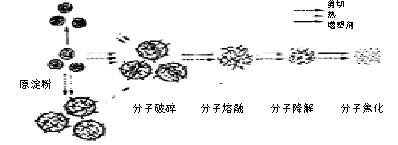Since the advent of starch degradable plastics, it has been rapidly developed. It has undergone three stages: filled starch plastics, graft copolymerized starch plastics and thermoplastic plastics.
Numerous studies have shown that early-developed starch-based plastics with 10% to 30% starch content can degrade only the starch fraction, and the rest of the starch fractions must be completely degraded over hundreds of years, plus the price of traditional plastics. High, unfavorable recycling, so this kind of degradable material is not really welcomed by everyone; subsequently developed a graft copolymerization starch plastic that has undergone physical or chemical modification of the original starch and then grafted and blended with the resin. Starch-based plastics have been popular for a while, but this starch plastic is still not ideal in processing and application performance, and the price is about 25% more expensive than the current plastic.
Thermoplastic starch (TPS) is a physical or chemical treatment of natural starch, making it thermoplastic processing, its starch content as high as 70% to 90%, and other added components can be completely degraded. As a new type of biodegradable material, thermoplastic starch plastic has advantages over the original starch-based plastics: thermoplasticity, complete degradation, and low cost.
Plasticizing Mechanism of Thermoplastic Starch
It is known that starch is a partially crystalline, naturally-occurring macromolecule with a double-helix structure. Starch molecules contain a large number of hydroxyl groups, making the intermolecular and intramolecular hydrogen bonding of starch very strong. The melting temperature is higher than the decomposition temperature, making it difficult to mold thermoplastics. The method is processed. Therefore, in order to make the original starch thermoplastic, the starch molecules must be deformed and disordered to form a thermoplastic starch resin. The processing principle of thermoplastic starch plastics is to destroy the original spherulite structure of starch under the action of heat, shear force and proper plasticizers, so that the starch forms an amorphous shape through glass transition and melting transformation and realizes a crystalline state. The irreversible transition to the amorphous state allows it to melt before starting thermal decomposition to form thermoplastic starch. Figure 1 is a schematic diagram of the transformation model of starch molecules in the extrusion process.

Figure 1 Transformation model of starch molecules in the extrusion process
Under the action of plasticizers, mechanical shear force and heat, the starch molecules undergo complete swelling through the process of swelling, fragmentation, opening of the double helix, and release of macromolecules. Three different levels of structural changes occurred during the conversion of raw starch to TPS: the breakdown of starch granules; the intramolecular and intermolecular hydrogen bonding of starch was weakened, some or all of the original crystals were lost and converted to none Definite morphology; partially degraded starch molecules resulting in reduced molecular weight. Therefore, depending on the degree of plasticization of starch, the resulting material is often composed of residual swelled starch granules, partially melted, deformed and broken starch granules, an amorphous form that is completely melted and plasticized, and a composite of starch recrystallized. Phase system.
The complexity of the starch structure has led to the processing of TPS much more complicated than the processing of general plastics. General plastics processing is mainly a melt-solidification process, and TPS processing involves plasticization, melting, volume expansion, degradation and physical and chemical reactions of starch. Since the processing properties of starch-based materials are controlled by the degree of plasticization of starch, the plasticization process of starch is particularly important, and the degree of plasticization is also affected by the plasticizer content, type and processing parameters.
During the processing of TPS, the use of plasticizers can significantly reduce the interaction between starch macromolecules, destroy the high degree of crystallinity of starch, and reduce the glass transition temperature of starch to have plasticity. Water is the most commonly used plasticizer. The water content in the processing of starch-based plastics is generally controlled below 20%. However, because water is extremely unstable during processing and volatile, it is often used in place of water. Such plasticizers are mainly polyhydric alcohols such as glycerin, sorbitol, and ethylene glycol, of which glycerin is most commonly used. Such plasticizers have large solubility parameters and contain groups that can interact with hydroxyl groups in the starch molecules, which can effectively weaken the hydrogen bonding between the starch molecules, thereby reducing the glass transition temperature of the starch. The degree of lowering of the glass transition temperature of starch is not only related to the type of plasticizer, but also related to the content of plasticizer. Therefore, the mechanical behavior of the material can be adjusted by changing the content of the plasticizer so as to obtain products with different properties. The data show that the plasticized starch shows a clear melting endotherm between 140 and 160 °C, indicating that the hydrogen bonds between starch molecules are weakened and destroyed, the diffusion capacity of the molecular chains is increased, and the glass transition of the material is improved. The temperature dropped. The double helix structure of natural starch is transformed into a random coil structure conformation, and the starch melts before the decomposition, so that the original starch has the possibility of thermoplastic processing.
Thermoplastic starch properties
First, thermoplastic
Thermoplasticity is one of the main indicators of measuring high molecular materials, especially the glass transition temperature Tg can determine the temperature of the material and the flexibility of the material. Starch's thermoplasticity has a great relationship with plasticizers and starch types. The effect of plasticizers is mainly reflected in the molecular weight. In general, plasticizers with relatively low molecular weights are more likely to enter the starch molecules and weaken the intermolecular hydrogen bonding force. Therefore, the plasticizers are more effective. However, the strength of the resulting product is worse. The Tg of the original starch was higher than 100 °C, but after plasticization in the presence of plasticizer, the Tg of the starch material decreased to about 80 °C, and gradually decreased with increasing plasticizer content. High amylose starch is more easily plasticized due to its lower crystallinity.
Second, rheological properties
The rheological properties of the melt are important parameters to measure the processing performance of the material. It reflects the flowability of the entire macromolecule, and the flowability will affect the ease of processing and the quality of the product. Thermoplastic starch plastics exhibit a pseudoplastic fluid in a viscous fluid state, and the apparent viscosity depends on the shear rate. Therefore, the melt viscosity can be adjusted by changing the shear rate to optimize the processing performance. The apparent viscosity of the material is also related to plasticizers, temperature, lubricants, water content, and the like. The plasticizer can not only reduce the resistance of the molecular chain, reduce the apparent viscosity and shear stress of the melt, but also reduce the viscous flow activation energy of the system, which in turn reduces the flow resistance of the melt. Temperature is also a very important factor because the melting of the starch crystal area is related to the plasticizing effect. Starch melts meet the exponential law:
τ=κγm, η=κγm-1
The index m increases with increasing temperature, but the constant k decreases with increasing temperature and water content.
Third, mechanical properties
The mechanical properties of the material are another focus of research on thermoplastic starch plastics. The special design of the equipment is one aspect of material performance optimization. On the other hand, the composition of the material also affects its mechanical properties. Relevant data shows that small-molecule polyol additives such as glycerin have a great influence on the mechanical properties of thermoplastic starch materials. The starch plasticized by glycerin has a higher elongation at break, and the higher its content, the higher the elongation at break, but the tensile strength decreases. Other polyol/starch systems show similar trends in mechanical properties. The effect of water on the mechanical properties of thermoplastic starch is similar to that of polyols, but the elongation at break varies. From the current level of technology, thermoplastic starch plastics have tensile strengths of 8 to 10 MPa and elongation at break of 150% to 200%, which can basically meet the requirements of the products, but still need to be further improved compared with ordinary plastics.
Fourth, degradation performance
Thermoplastic starch plastics are fully biodegradable. The biodegradability of starch can be determined by the ratio of Biological Oxygen Demand (BOD) to Chemical Oxygen Demand (COD), and the material decomposes within approximately 40 days. Another method for investigating the biodegradability of thermoplastic starch is to use gel permeation chromatography (GPC) measurements to control molecular fragmentation of the thermoplastic starch plastic under mixing conditions. Four weeks after mixing, the molecules form a distinctly low molecular weight distribution.
Application and Prospect
As a fully biodegradable material, thermoplastic starch plastics can be used in many applications instead of ordinary plastics. Thermoplastic starch plastics are used in many aspects of packaging. They can be used in agriculture as slow-release coating materials for pesticides and fertilizers. In foods, they can meet the requirements for direct contact with food, and can be used for the packaging of dry solid foods. Dairy products and sweets can also be used in fast food containers, disposable plastic knives and forks, supermarket food packaging boxes and packaging bags, etc.; can also be used to replace polyethylene/bonded layers of paper/polyethylene/metal foil laminates to make multi-layers Recycling of packaging materials becomes easy.
With regard to the development of thermoplastic starch plastics, there are still some difficulties that have not been overcome. For example, such materials are too expensive, water-resistant, and mechanically inadequate. With the enhancement of environmental awareness and technological advancement, various properties of degradable plastics will also be continuously improved, and it is expected to replace ordinary plastics in a wider range, especially in the fields of plastic films, packaging materials, and medical materials. There is no doubt that the potential market for biodegradable plastics is enormous. The development and application of this new material will replace the areas that have been monopolized by synthetic materials in the past 40 years and open up a brighter path for the packaging industry that is environmentally friendly.
Currently abroad, the Battelle Research Institute in Frankfurt, Japan, Sumitomo Corporation, BIOTEC in Germany, National Foam Compound Company in the United States, Warner lambert in the United States, and Ferrizz in Italy all claim to have successfully developed this thermoplastic starch plastic. Production of films, sheets, etc. Domestic Zhejiang University, Tianjin University, etc. have done some work on starch thermoplasticization, but none have entered the development stage of thermoplastic starch plastic products. The Institute of Applied Research of the Jiangxi Academy of Sciences used four different processes to disorder the starch, to produce SP-98 thermoplastic starch plastic and process it into thin sheets and films, and is further improving its relative performance. As the development direction of degradable plastics, thermoplastic starch plastics have an attractive market prospect.
Reprinted from: China Zhejiang Online Technology Market
We can provide you with a variety of sizes of Paper tube/Cylinder Box. This round cardboard boxes with lids, the use of the main material is a thickness of 1-2 mm cardboard, you can customize the Paper tube/cylinder box with your business information and product information printed on the box, play a promotional product with the role of the company`s brand.

Cylinder Box,Paper Tube Box,Cylinder Gift Box,Cylinder Box With Lid
Shenzhen Hongte Printing & Packaging Co., Ltd. , http://www.ipackpaperbox.com